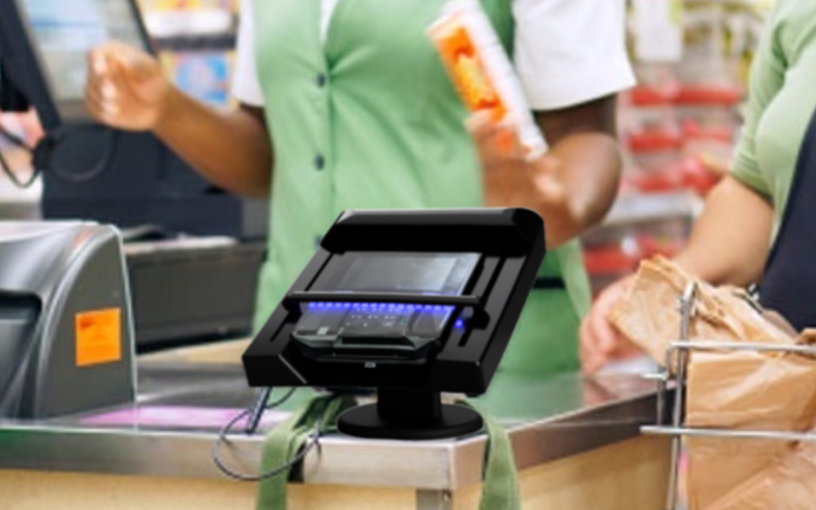
UV-C Light Touted As Quick Disinfecter For Touchscreens, Payment Terminals, But Is It A Feasible Alternative To Hand Gel?
January 4, 2022 by Dave Haynes
I’ve not yet seen much at all in the way of digital signage and commercial AV-related product announcements coming out of the (in normal times) giant CES electronics trade show in Las Vegas, but was a little curious about a Florida company called LumixUV that has what it calls “groundbreaking robotic disinfection technology” that would rid things like point of sale terminals and touchscreens of transmissable diseases.
The company says high-powered UV-C LED lights in their set-up would pass over POS terminals and self-service touchscreens to “disinfect at a level comparable to Lysol or alcohol, without the risk of damaging the terminal that comes along with applying liquid disinfectants.”
LumixUV suggests UV-C LED lighting has been “scientifically proven” as an antimicrobial approach against most strains of bacteria and viruses, though it doesn’t specifically mentionCOVID-19. “Eighty percent of illness-causing germs are spread by our hands and POS terminals are touched by hundreds of people — if not more — on a daily basis. UV-C disinfection is effective in maintaining cleaner, safer, high-touch surfaces. Human behavior is difficult to change – it took over 100 years for hand-washing to become commonplace after it was discovered to be effective in reducing the transmission of illness. Implementing effective and automated disinfection systems in high-risk areas – and doesn’t rely on humans, is critical in preventing the spread of disease,” says Mark Lyle, co-founder of LumixUV.
LumixUV says payment systems are the main use-case, but it is is also adapting its tech to work with things like self-serve screens at airports, offices, and other “high-touch surface applications.”
This kind of tech built around virus-killing UV light is not new, but the coronavirus that keeps evolving and sticking around has maintained interest and a potential market. You can Google and pretty quickly come up with other UV light sterilizing systems, all the way to ones that are like invisible room dividers.
There are numerous challenges with this sort of thing, the biggest ones being hardware cost and the utter lack of universality in the size, shape and workings of things like payment terminals and touchscreen kiosks. Thing of all the payment terminals out there in different shops and restaurants, and how they all seem to be a bit different from one another.
There’s also the science. There is backing for the assertion that UV-C light works, but there are also questions around how long it takes, the required energy consumption, how strong the light needs to be, and what the impacts are on the equipment and on consumers. One touchscreen expert told me: “The stronger the UV energy, the faster it works. Also, the stronger the UV energy, the greater the risk of harm to humans. We could never find a balance where we were 100% confident the UV could be applied at a level required, within an acceptable amount of time, that we could guarantee would not harm a person. Issues like if the unit is damaged by a user, and then another user is harmed, scared us away.”
My sense is that technology gets beyond interest to adoption when it does something faster, better and easier, and reduces costs. If this sort of thing adds times to transactions, after also adding new costs for hardware, installation and maintenance, I’m not sure how broad the adoption might be.
A couple of years ago, when COVID-19 first became part of our daily conversation, there was a sense touchscreen vendors were in for a world of hurt. There were UV light solutions and antimicrobial surfaces floated as solutions, but they did not get a lot of adoption. We’re now so conditioned to hand sanitizer being part of our consumer journeys that I wonder how much demand there really is for these instant or quick kill solutions, particularly when they add cost at a time when a lot of retail is struggling.
I don’t think many of the digital signage and pro AV vendors who invested in and marketed things like infrared temperature reader screens and screens with hand sanitizer squirters built-in made a killing with them, and I hear stories of unsold inventory languishing in vendor storage areas.
There are also companies showing UV-C solutions at NRF in NYC in a couple of weeks (IF that show happens).
This sort of thing could be great. I don’t want to get a head cold – never mind a possibly lethal coronavirus – from boinking away at a screen. But for it to work and get take-up, it’s going to have to be fast, SUPER-reliable, safe and inexpensive. If all those things line up, maybe there’s a market.



They are a new solution (see web.archive.org). Airlines and hospitals have experimented with robotic disinfection. I tend to favor periodic disinfection with handheld emitter. American UltraViolet is the best provider of UV solutions and will also consel on dangers on — https://kioskindustry.org/uv-antibacterial/
The power of UV (A/B and C) light is both a benefit and danger; UV must be skillfully managed. Intensity, duration and wavelength coupled with illumination uniformity are critical. Safety to any living tissue in UV exposure must be understood. Eye safety remains paramount.